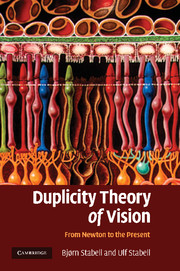Book contents
- Frontmatter
- Contents
- Acknowledgements
- 1 Introduction
- Part I The development of the basic ideas of the duplicity theory from Newton to G. E. Müller
- Part II The development of the duplicity theory from 1930–1966
- Part III Chromatic rod vision: a historical account
- 11 Night vision may appear bluish
- 12 Mechanisms of chromatic rod vision in scotopic illumination
- 13 Rod-cone interactions in mesopic vision
- 14 Further exploration of chromatic rod vision
- Part IV Theories of sensitivity regulation of the rod and cone systems: a historical account
- Part V Factors that triggered the paradigm shifts in the development of the duplicity theory
- References
- Index
13 - Rod-cone interactions in mesopic vision
Published online by Cambridge University Press: 22 January 2010
- Frontmatter
- Contents
- Acknowledgements
- 1 Introduction
- Part I The development of the basic ideas of the duplicity theory from Newton to G. E. Müller
- Part II The development of the duplicity theory from 1930–1966
- Part III Chromatic rod vision: a historical account
- 11 Night vision may appear bluish
- 12 Mechanisms of chromatic rod vision in scotopic illumination
- 13 Rod-cone interactions in mesopic vision
- 14 Further exploration of chromatic rod vision
- Part IV Theories of sensitivity regulation of the rod and cone systems: a historical account
- Part V Factors that triggered the paradigm shifts in the development of the duplicity theory
- References
- Index
Summary
ROD-CONE INTERACTIONS UNDER MESOPIC CONDITIONS IN A CHROMATICALLY NEUTRAL STATE OF ADAPTATION
In the period from Schultze (1866) to Lie (1963) it had been generally agreed that rods and cones interacted in a kind of colour-mixture process in mesopic vision. Rods and cones were assumed to contribute an achromatic and a chromatic component, respectively. The most advanced attempt to further characterize the rod-cone interaction under mesopic conditions had been made by Granit (1938, 1947) and Lie (1963). They both suggested that rod and cone activities antagonized each other at the retinal level in that the most sensitive receptor system tended to suppress the other. The rise of the specific-hue threshold obtained when rods intruded during long-term dark adaptation was compelling evidence in favour of this antagonistic interaction. There could be little doubt that rod signals completely suppressed the chromatic cone signals within the intensity interval between the cone-plateau level and the specific-hue threshold.
Yet, in apparent opposition to the psychophysical data and the hypothesis of rod-cone antagonism proposed by Lie (1963), the histological and electrophysiological evidence obtained in the late 1980s and early 1990s indicated that rods and cones added their responses of the same polarity both at the receptor and bipolar cell levels (Daw et al., 1990; Schneeweis & Schnapf, 1995).
Fortunately, this apparent conflict between the psychophysical and the electrophysiological data could easily be resolved.
- Type
- Chapter
- Information
- Duplicity Theory of VisionFrom Newton to the Present, pp. 120 - 123Publisher: Cambridge University PressPrint publication year: 2009



